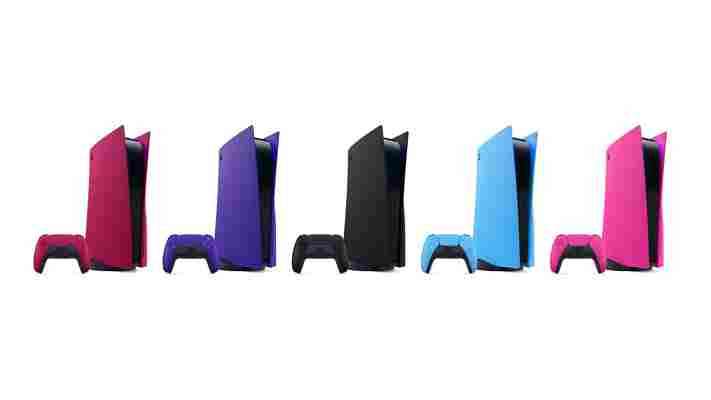Sony finally announced official PS5 covers at the end of last year, giving you the opportunity to customise the color of your console's faceplate. In a post on the official PlayStation Blog , five new PS5 covers were revealed for the standard console and Digital Edition that can liven up the original plain white design.
The Midnight Black and Cosmic Red variants were made available first from the PlayStation Direct store on January 21, and you can order them now for $54.99/£45.99.
These two will then go on a wider release at other retailers from February 18. The three other colors – that's Nova Pink, Starlight Blue and Galactic Purple – will launch later in 2022.
The release of these official PS5 covers comes after Sony took legal action against a peripheral company selling third-party custom faceplates back in November 2020.
This forced the company to cancel all existing orders and pull all of the faceplates from sale. Almost one year later, Sony would secure a patent to sell its own PS5 faceplates , which brings us to today and the launch of its official PS5 console covers in Midnight Black and Cosmic Red, with more scheduled to launch later in 2022.
If you fancy getting one for yourself to spruce up your console, or you've just bought a console through our PS5 restock hub, here's where to buy the PS5 covers right now.

PS5 console covers - where to buy in the US
Only the PlayStation Direct store in the US is currently taking orders for the new PS5 covers for $54.99 following today's January 21 launch. You can choose between Midnight Black and Cosmic Red for either the standard PS5 or PS5 Digital Edition. As soon as other retailers list the PS5 covers for sale we'll add them below.
PS5 console covers - where to buy in the UK
As with the US, the only place to order the upcoming PS5 console covers is the PlayStation Direct store. Launched on January 21, both the Midnight Black and Cosmic Red versions can be purchased for the PS5 or PS5 Digital Edition at £45.99. You'll be able to order from other retailers once the new PS5 accessories go on a wide release from February 18. The remaining three colors go on sale later in 2022.
The news of these PS5 console covers came alongside the announcement of three new PS5 DualSense controller colors . If you're looking for the best price on those, we monitor all the cheapest PS5 controller deals every month. You can also find discounted games, accessories and more in our PS5 deals hub.
More PS5 deals
NFTs, blockchain and the metaverse are turning our world into The Matrix
The Matrix is one of the most iconic sci-fi movies of all time . This dystopian action film changed how we think about the future, technology, and the increasingly blurred lines between the real and virtual worlds.
In this blockbuster from 1999, intelligent machines have won the war against humans, who pay the ultimate price. Their bodies are enslaved for their energy while their minds are occupied within the Matrix, a simulated reality designed to make them believe everything is as it always was.
The Matrix raises a thought-provoking question: would you rather stay in the comfort of an artificial world or face the harsh truths of an unknown reality?
As a result of recent technological developments, this may be a question humanity is forced to answer sooner rather than later. Many experts have warned about the dangers posed by artificial intelligence , and the popularization of blockchain, NFTs and the metaverse add fuel to the debate. Will these technologies help us better our lives? Or are they guiding us towards a darker, more Matrix-esque world, wherein we spend more and more time in a virtual space we can’t escape?
Our evil overlords aren’t running the show just yet. However, our increased dependence on technology for working, living, and connecting with others does raise important questions about how much time is ‘too much’ to spend in a virtual world and what risks and dangers are associated with virtual reality and technology.
Looking through the lens of three of the most high-profile tech concepts in recent years - NFTs, blockchain, and the metaverse - here’s what we need to consider.
NFTs
Walking through any art gallery, you’ll see priceless works of art by famous painters throughout history. But could a digital file ever be thought of as a piece of artwork, equal in value to masterpieces by Cézanne or Van Gogh?
Enter the NFT, or non-fungible token . In simple terms, an NFT is an individual unit of data, recorded and stored on a digital ledger known as a blockchain. Non-fungible means the item is one-of-a-kind, unable to be copied or substituted — just like the Mona Lisa.
The NFT contains unique ownership data, so NFTs aren’t the artwork itself but rather a method used to record the ownership of digital art — otherwise, anyone can claim to own the original of a digital art file.
They first appeared in 2017 with the launch of CryptoPunks but didn’t take off until early last year. Now, NFTs have taken the art world by storm.
NFT technology allows artists and collectors to connect directly, but NFTs also give us a way to verify ownership of digital art, rare in-game items, virtual spaces, and domain names. In a virtual world, NFTs will become increasingly important. You’ll not only display your digital art within the metaverse, but NFTs will also represent ownership of digital items, such as the clothes and accessories worn by your avatar and the purchases you make within the digital world you spend time in.

Will digital art ever replace that priceless watercolor hanging on your wall? It’s doubtful, as physical arts such as paintings, sculptures, and photography will always hold value to collectors, whether it’s sentimental or monetary.
There is also a dark side to the world of NFTs, which is currently subject to no direct regulatory guidance, although it’s possible the US government could categorize NFTs as securities or commodities in the future. Like fine art, NFTs are only worth what people will pay for them and the level of volatility in the NFT (and cryptocurrency) space is extreme. No investment is ever a guaranteed success and the NFT field is purely speculative, so it’s easy to lose money with NFTs if you’re not careful.
Artists are also at risk of art theft, plagiarism, and fraud, with the virtual world giving users anonymity that unscrupulous art thieves can use to their advantage. NFTs also raise some concerning environmental issues, as the Ethereum blockchain on which most of them sit demands a huge amount of energy to sustain itself.
As with any unregulated space, there’s plenty that can go wrong, with concerns that the NFT market can be used as a type of pyramid scheme, which sees early investors making huge gains but newcomers struggling to recoup their losses.
The allure of digital art investing is appealing to many and can be a lucrative and fun way to support the creative arts, but as with any new investment, caveat emptor .
Blockchain
If you’ve ever dabbled in Bitcoin, you will have utilized blockchain technology - only probably without knowing it. A blockchain is a digital ledger of transactions that provides a high-level of security and transparency. While blockchain has many uses, it plays an essential role as the ledger behind most cryptocurrencies, including Bitcoin and Ether.
In the future, however, the role of blockchain is likely to expand, as it can also be used to verify digital identity, store and protect data, and allow for secure digital voting — all essential elements in keeping people safe in a digital world.
With companies increasingly accepting cryptocurrency as payment and El Salvador becoming the first country to make Bitcoin legal tender, more and more of us are investing in digital currencies and therefore becoming dependent on the security of blockchains to protect our finances.
But just like the Matrix itself, the long-term importance of cryptocurrency may turn out to be an illusion that we’ve bought into. As with NFTs, the crypto market is decentralized and speculative, and it’s also the largest unregulated market in the world. While investors have been lured in by the lucrative growth in Bitcoin, as well as the opportunity for disintermediation and higher levels of financial privacy it affords, cryptocurrencies aren’t backed by any government or bank or FDIC insurance, making them riskier than traditional currencies.

The lack of regulatory oversight and anonymity associated with crypto also makes it attractive to the nefarious characters of the digital world. It’s harder to track and trace so it appeals to criminals, with digital currencies used for ransomware attacks, money laundering, dark web transactions, terrorism, and illegal drugs on an international scale.
While a recent study estimated that only 3% of Bitcoin transactions involve illegal activity and authorities are becoming better at analyzing transactions on a blockchain, that’s not to say the technology isn't still problematic.
Many investors, especially younger ones new to the market, turned to crypto during the pandemic as a new hobby — it’s thought that 16% of American adults owned or invested in crypto in 2021. While it’s clear demand is higher than ever before, do we, as a society, want to be moving our investments and finances into an unregulated, digital world?
Increased governmental oversight is one way to manage the risks of crypto — the Federal Reserve and US banking regulatory bodies have officially added cryptocurrency to the agenda for 2022 , with plans to discuss regulatory standards, crypto-backed loans, and liquidity requirements for banks. As crypto becomes more mainstream, some form of regulation seems inevitable, giving authorities more power to curb illegal activity.
But how can you effectively regulate a currency that’s completely decentralized and doesn’t fall under any particular jurisdiction? While governments around the world are working on it, there are more questions than answers at this point.
The metaverse
In The Matrix , Neo is offered a red pill or a blue pill. The blue will send him back to the familiar comfort of the Matrix, while the red will bring him into a harsh and uncertain reality. Today, this iconic set piece feels more relevant than ever, with the emergence of the concept of the metaverse.
The metaverse is imagined as a place where users connect online, in virtual spaces, with the help of virtual reality headsets and other technology. Represented by your avatar, you will be able to move through the metaverse just as you would in real-life. In the metaverse, you can attend virtual meetings , go to concerts, shop, and attend conferences , all from the comfort of your home. And yes, you’ll be able to display your NFT purchases within the metaverse — that you purchased with blockchain-based cryptocurrencies.
It’ll be an important part of Web 3.0, the latest imagining of the internet as a decentralized space where users have more autonomy, control, and connection opportunities without a central authority.
When Facebook CEO Mark Zuckerburg announced in October that the company was changing its holding company name from Facebook to Meta, signaling an increased focus on the metaverse, millions wondered what that meant for the future and how intertwined our lives might become with virtual reality. But it’s not just a Zuckerberg pipedream; scores of corporate giants have already invested serious resources into the metaverse.
Tech heavyweights like Sony and Microsoft see huge value in a fully-realized metaverse, but even retail companies like Chipotle and Nike are ready to sell their virtual products in this new virtual world, and investment funds are springing up to help investors get a piece of the pie.

It might sound appealing, but the metaverse is also fraught with potential issues , including identity theft , fraud, and security concerns — all legal landmines yet to be sorted out.
Living our lives in a virtual reality world would bring other risks too. We already know how addictive screen time can be, especially for developing minds, so how much worse would an immersive 3D online world be for internet addiction, compared to Facebook and the social media platforms we already use?
Spending more and more hours online can contribute to many serious issues , including a sedentary lifestyle, high blood pressure, depression, withdrawal from society, and confusion as to what’s real and what isn’t. If our children come of age in a predominantly virtual world, what does that mean for their future and wellbeing?
So, would you prefer the blue pill of the metaverse or the red pill of the real world? Luckily, no one is asking us to make that decision just yet. The metaverse is still years from being fully realized as per Meta’s dreams, but it does raise the important question: how much of our working and personal lives are we comfortable spending in virtual spaces?
Yes, the metaverse offers entertainment, immersive remote work opportunities, and new ways to socialize, but it’s also important to consider both the physical and mental health risks of spending too much time online, especially for our kids and teens.
Is technology for us, or against us?
One of the underlying messages of The Matrix is one of personal responsibility — we all have free will to choose between virtual and real worlds. The same applies to our increasingly digital lifestyles, with all of us having at least some ability to determine how much of our time, interests, and finances we’re investing into new technologies and virtual platforms.
In recent years, technological developments have offered so many benefits and conveniences, allowing us to connect, work, shop, game and access healthcare in ways we never have before. These advances have been all the more meaningful during the pandemic, which forced people into isolation.
On an individual level, many of us have also been captivated by cryptocurrencies and NFTs, and are excited about the possibilities the metaverse can bring. Technology has a long history of improving our lives and connections to others, and these new developments may be no different.
However, it’s always worth taking time to understand the dangers of any new type of technology, ensuring you don’t risk detrimental impacts to your finances, wellbeing and health.
Technology is also created by humans, of course, which means we have the power to build and shape it to meet our needs. Even if you don’t work in tech yourself, you can always vote with your wallet, choosing to support tech companies and investments you believe are ethical and safe.
As Morpheus states in The Matrix , “What is real? How do you define 'real'? If you're talking about what you can feel, what you can smell, what you can taste and see, then 'real' is simply electrical signals interpreted by your brain”.
As an increasingly virtual world leaves us wondering what’s real and what isn’t, remember that technology is there to enhance our lives, not to dominate them.
Why the new Canon EOS R5 C doesn't rule out a flagship Canon EOS R1
If you missed the Canon EOS R5 C launch, the quick summary is that the Canon EOS R5 has a new Cinema-focused sibling – a fan-cooled filmmaking machine that extinguishes any concerns about overheating. But while the EOS R5 C is the closest thing that Canon has made to a true hybrid camera, it's no flagship – and its idiosyncrasies leave a convenient gap for a true Sony A1 rival.
This might seem like an odd conclusion to make about the arrival of such a powerful full-frame camera. After all, does the world really need a flagship when the R5 twins complement each other so nicely? The EOS R5 is for hybrid shooters who lean towards photography, while hybrid videographers who need a small body have a fine new option in the EOS R5 C. Where an EOS R1 fits into this equation is certainly up for debate.

But it's the style of the Canon EOS R5 C, along with ongoing rumors about a Canon EOS R1, that suggest the camera giant is leaving space for one over-arching hybrid flagship. Rather than melding two experiences, the EOS R5 C is effectively two current cameras bolted together – switch its dial to 'photo' mode, and you can't even shoot video at all (and vice versa).
This approach allows Canon to put the full Cinema EOS experience, with all its familiar menus, into the camera without muddying it with a photography UI. But while that makes complete sense for the EOS R5 C's target audience (pro filmmakers), it also means the camera doesn't offer a truly seamless, next-gen hybrid experience. And that's the spot where the Canon EOS R1 will, along with other innovations, likely land with great fanfare in the relatively near future.
One to rule them all
The Canon EOS R1 rumors have simmered down considerably in the past few months, but the flagship camera is still expected to land in late 2022 or early 2023.
With the recent arrival of the Canon EOS R5 C and Canon EOS R3 , the camera giant understandably isn't in a huge rush. Those cameras amply cover the needs of pro video and stills shooters, with the EOS R5 and EOS R6 the sweet spots for advanced amateur snappers.
But the usually reliable Canon Rumors recently claimed that the EOS R1 is "definitely being worked on already", with Canon aiming to collect "as much feedback as they can from the Canon EOS R3" ahead of a possible launch in the last few months of 2022.

The only reason why Canon needs to consider an EOS R1 at all is pretty simple: the existence of the Sony A1 and Nikon Z9 . Both of those cameras are the most powerful image-making machines that either brand has ever made, by some distance. And while none of Canon's existing EOS R range is exactly underpowered, it doesn't have a single hybrid camera that quite matches those flagships.
Some would argue, quite fairly, that it doesn't need to. Back when the Sony A1 launched, we argued that it was proof that the 'no compromise' camera isn't possible , just like the myth of the 'perfect' car. Every camera is a compromise in some way, even if that's down to price and usability, and the existence of the Canon EOS R5, EOS R5 C and EOS R3 shows that pros still want specialist tools – but that doesn't mean an EOS R1 isn't en route.
Stacked in its favor
So what exactly could the Canon EOS R1 offer that isn't already covered by Canon's existing models? Traditionally, Canon's 1-series has been aimed at professional sports and wildlife photographers, but that's now covered by the Canon EOS R3. So the most likely scenario is a flagship 'all-rounder' camera in the spirit of Canon's 5D series.
This is the role currently fulfilled by the Canon EOS R5. But the price difference between the EOS R5 ($3,900 / £4,200 / AU$6,899) and Sony A1 ($6,500 / £6,500 / AU$10,499) suggests there is still room for a true Canon flagship with next-gen technology, including a stacked sensor, that could again see the camera giant wrestle the 'innovation halo' back from Sony.

The arrival of full-frame stacked sensors, which provide lightning-fast readout speeds, has changed the game for mirrorless cameras. It's now possible for 50MP models like the Sony A1 to shoot at 30fps, giving them true all-rounder status. But so far, Canon's only camera with a full-frame stacked sensor has been the Canon EOS R3 – and the manufacturer was pretty clear that the R3 isn't a 'flagship' camera.
That almost certainly leaves room for a Canon EOS R1 – and it's a space that hasn't been filled by the Canon EOS R5 C, despite its impressive hybrid powers. While the EOS R5 C sits in Canon's Cinema EOS line and bolts two cameras together, giving it some battery-related restrictions in its high frame-rate modes, the EOS R1 will likely be an EOS R hybrid camera to rule them all.
Renewed focus
There have been some outlandish rumored specs for the Canon EOS R1, including an 85MP sensor with a global shutter, a new Quad Pixel autofocus system, nine-stop in-body image stabilization, a 9.44MP electronic viewfinder and even a new 'donut' design that we found strangely compelling .
These specs are most likely a wishlist rather than anything grounded in concrete substance. And more recently, Canon Rumors has suggested that a global shutter – which simultaneously captures all the info from a sensor's photodiodes, rather than in a traditional 'rolling' fashion – is now looking less likely for the EOS R1, with sensor readout speeds and processing power "negating the need for a global shutter".
In some ways, these processing leaps mirror the leaps made by the latest camera phones, and could help propel some next-gen advances in the Canon EOS R1. For example, could the 'quad pixels' rumored for the new Quad Pixel AF system also combine to allow the EOS R1 to offer multiple resolution modes, like 80MP for stills and 20MP for video?
Processing power could also give Canon additional firepower in that key mirrorless camera battlefield: autofocus. A more versatile version of the Eye Control AF seen in the EOS R3 would be very welcome, as would a truly intelligent tracking AF system. Right now, you still have to go into a camera's menus to choose 'human', 'animal' or 'vehicle' tracking, depending on your subject. Sometime soon, a camera will be able to do that for you – and that would be a fine trick for a flagship EOS R1.
One direction
The Canon EOS R1 may still be in the realm of rumor and speculation, but the arrival of the powerful-but-specialist Canon EOS R5 C hasn't quelled those whispers – and if anything, its idiosyncrasies leave room for a true hybrid flagship aimed at well-heeled enthusiasts and pros.
The mirrorless camera wars are, after all, as much about perception as sensors, lenses and camera bodies. And having a single 'halo' flagship, while not necessarily as practical for pros as a specialist tool like the EOS R5 C, is one of the best ways to get the flashbulbs pointing in your direction and convincing floating voters that your system is the one to invest in.
Back when the Canon EOS 5D Mark IV launched in 2016, it was a huge leap forward for hybrid cameras, in a similar fashion to the ground-breaking EOS 5D in 2005. While the Canon EOS R5 C is shaping up to be a fine tool for mobile filmmakers and does an admirable job at combining the worlds of its Cinema EOS cameras and EOS R cameras, a true flagship hybrid remains very likely – the only question is when, rather than if.